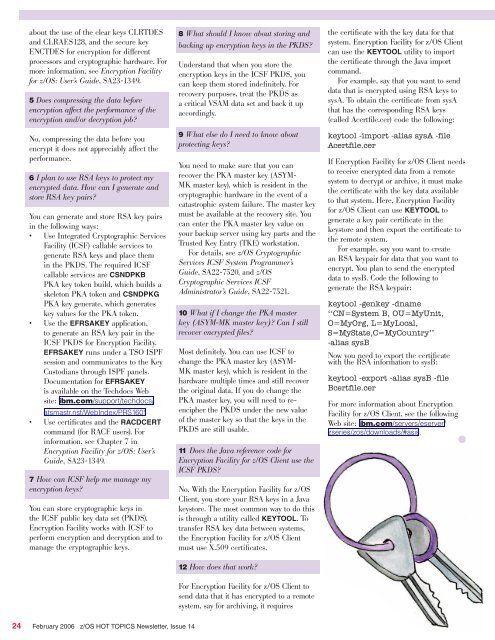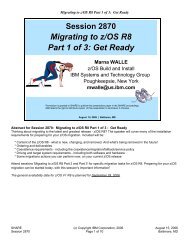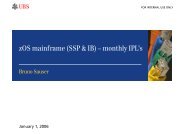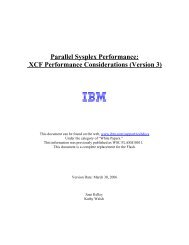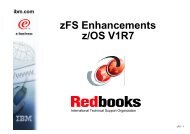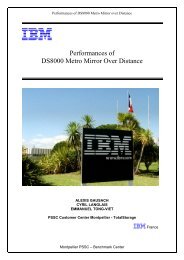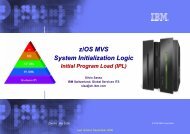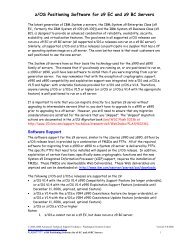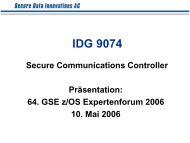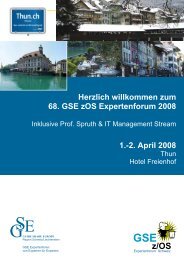Hot Topics - Messmer The Brain House
Hot Topics - Messmer The Brain House
Hot Topics - Messmer The Brain House
Create successful ePaper yourself
Turn your PDF publications into a flip-book with our unique Google optimized e-Paper software.
about the use of the clear keys CLRTDES<br />
and CLRAES128, and the secure key<br />
ENCTDES for encryption for different<br />
processors and cryptographic hardware. For<br />
more information, see Encryption Facility<br />
for z/OS: User’s Guide, SA23-1349.<br />
5 Does compressing the data before<br />
encryption affect the performance of the<br />
encryption and/or decryption job?<br />
No, compressing the data before you<br />
encrypt it does not appreciably affect the<br />
performance.<br />
6 I plan to use RSA keys to protect my<br />
encrypted data. How can I generate and<br />
store RSA key pairs?<br />
You can generate and store RSA key pairs<br />
in the following ways:<br />
• Use Integrated Cryptographic Services<br />
Facility (ICSF) callable services to<br />
generate RSA keys and place them<br />
in the PKDS. <strong>The</strong> required ICSF<br />
callable services are CSNDPKB<br />
PKA key token build, which builds a<br />
skeleton PKA token and CSNDPKG<br />
PKA key generate, which generates<br />
key values for the PKA token.<br />
• Use the EFRSAKEY application,<br />
to generate an RSA key pair in the<br />
ICSF PKDS for Encryption Facility.<br />
EFRSAKEY runs under a TSO ISPF<br />
session and communicates to the Key<br />
Custodians through ISPF panels.<br />
Documentation for EFRSAKEY<br />
is available on the Techdocs Web<br />
site: ibm.com/support/techdocs/<br />
atsmastr.nsf/WebIndex/PRS1601<br />
• Use certificates and the RACDCERT<br />
command (for RACF users). For<br />
information, see Chapter 7 in<br />
Encryption Facility for z/OS: User’s<br />
Guide, SA23-1349.<br />
7 How can ICSF help me manage my<br />
encryption keys?<br />
You can store cryptographic keys in<br />
the ICSF public key data set (PKDS).<br />
Encryption Facility works with ICSF to<br />
perform encryption and decryption and to<br />
manage the cryptographic keys.<br />
24 February 2006 z/OS HOT TOPICS Newsletter, Issue 14<br />
8 What should I know about storing and<br />
backing up encryption keys in the PKDS?<br />
Understand that when you store the<br />
encryption keys in the ICSF PKDS, you<br />
can keep them stored indefinitely. For<br />
recovery purposes, treat the PKDS as<br />
a critical VSAM data set and back it up<br />
accordingly.<br />
9 What else do I need to know about<br />
protecting keys?<br />
You need to make sure that you can<br />
recover the PKA master key (ASYM-<br />
MK master key), which is resident in the<br />
cryptographic hardware in the event of a<br />
catastrophic system failure. <strong>The</strong> master key<br />
must be available at the recovery site. You<br />
can enter the PKA master key value on<br />
your backup server using key parts and the<br />
Trusted Key Entry (TKE) workstation.<br />
For details, see z/OS Cryptographic<br />
Services ICSF System Programmer’s<br />
Guide, SA22-7520, and z/OS<br />
Cryptographic Services ICSF<br />
Administrator’s Guide, SA22-7521.<br />
10 What if I change the PKA master<br />
key (ASYM-MK master key)? Can I still<br />
recover encrypted files?<br />
Most definitely. You can use ICSF to<br />
change the PKA master key (ASYM-<br />
MK master key), which is resident in the<br />
hardware multiple times and still recover<br />
the original data. If you do change the<br />
PKA master key, you will need to reencipher<br />
the PKDS under the new value<br />
of the master key so that the keys in the<br />
PKDS are still usable.<br />
11 Does the Java reference code for<br />
Encryption Facility for z/OS Client use the<br />
ICSF PKDS?<br />
No. With the Encryption Facility for z/OS<br />
Client, you store your RSA keys in a Java<br />
keystore. <strong>The</strong> most common way to do this<br />
is through a utility called KEYTOOL. To<br />
transfer RSA key data between systems,<br />
the Encryption Facility for z/OS Client<br />
must use X.509 certificates.<br />
12 How does that work?<br />
For Encryption Facility for z/OS Client to<br />
send data that it has encrypted to a remote<br />
system, say for archiving, it requires<br />
the certificate with the key data for that<br />
system. Encryption Facility for z/OS Client<br />
can use the KEYTOOL utility to import<br />
the certificate through the Java import<br />
command.<br />
For example, say that you want to send<br />
data that is encrypted using RSA keys to<br />
sysA. To obtain the certificate from sysA<br />
that has the corresponding RSA keys<br />
(called Acertfile.cer) code the following:<br />
keytool -import -alias sysA -file<br />
Acertfile.cer<br />
If Encryption Facility for z/OS Client needs<br />
to receive encrypted data from a remote<br />
system to decrypt or archive, it must make<br />
the certificate with the key data available<br />
to that system. Here, Encryption Facility<br />
for z/OS Client can use KEYTOOL to<br />
generate a key pair certificate in the<br />
keystore and then export the certificate to<br />
the remote system.<br />
For example, say you want to create<br />
an RSA keypair for data that you want to<br />
encrypt. You plan to send the encrypted<br />
data to sysB. Code the following to<br />
generate the RSA keypair:<br />
keytool -genkey -dname<br />
‘‘CN=System B, OU=MyUnit,<br />
O=MyOrg, L=MyLocal,<br />
S=MyState,C=MyCountry’’<br />
-alias sysB<br />
Now you need to export the certificate<br />
with the RSA information to sysB:<br />
keytool -export -alias sysB -file<br />
Bcertfile.cer<br />
For more information about Encryption<br />
Facility for z/OS Client, see the following<br />
Web site: ibm.com/servers/eserver/<br />
zseries/zos/downloads/#asis.


